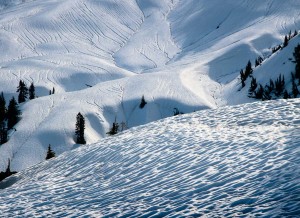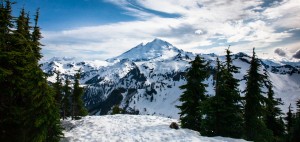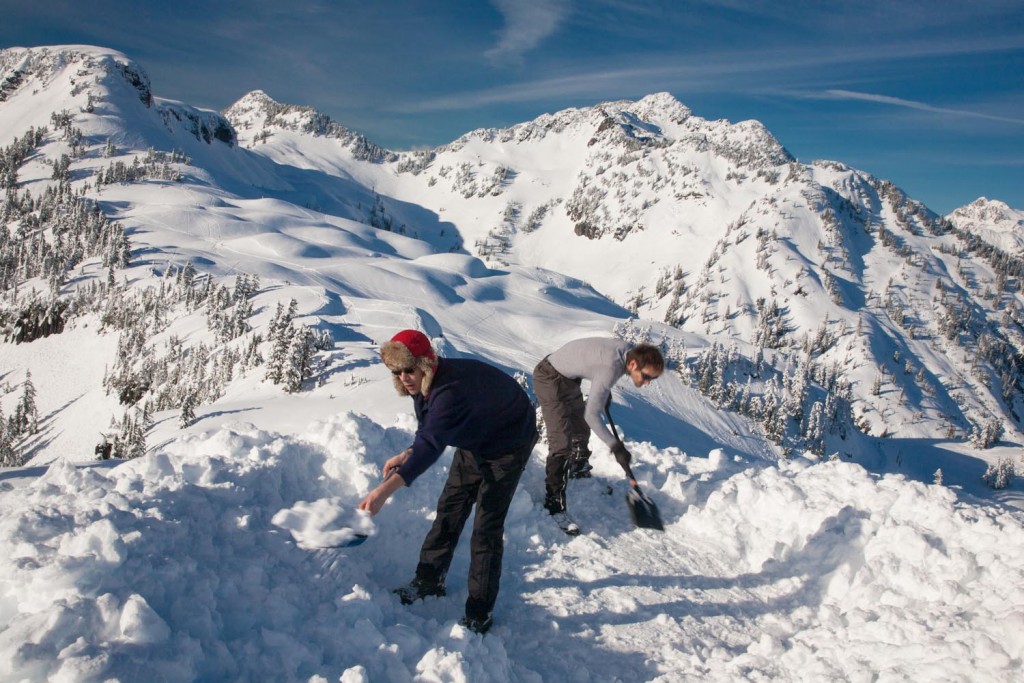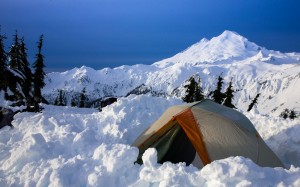The journey to Huntoon Point on a winter’s day, when measured in miles, is very short.
A mere three miles separate you from the clamor and bustle of the parking lot and the spirit-lifting hush of this magical destination. And it’s easy too. You’ll climb a scant 1200 feet along the way with only a few short steep bits, and even these are hugely mitigated by the soul-surging views of snow-softened peaks and glittering meadows.
The true measure of the journey is found within, as the volume goes down, the breathing grows deeper (admittedly, the climbing with that) and the internal babbling slows to a pleasing hum.

As a day trip, it’s superb. But taken a little more seriously, as an overnight excursion – under the right conditions – it can really be sublime. For me it tends to be a high point of the winter, in every sense of the word.
Sometimes I make the trip on my backcountry skis, but lately I have gravitated towards snowshoes, which are easier to manage the backpack and better suited to stopping for the occasional impossible-to-resist photo op along the way. There tend to be rather a lot of these.
I’ve been making it a priority to spend at least one night each winter on the point for many years. I’ve missed a few years – but not many. These nights really resonate. The stars on a clear, cold winter’s night can really put things into perspective. The silence is a presence, and in my experience, quiets the mind. It is good to get away from the beeping and pop-ups for a while.
Of course, sometimes it snows. A lot. This too can be a delight. And sometimes the wind blows, roughing up one’s face like a rat-tail file. It goes without saying that you must be prepared.
Obviously, if the weather forecast is unfavorable, go to plan B: an evening in your hot tub, listening to Vivaldi.
In summer, Huntoon Point is crawling with giddy day-hikers, taking pictures of each other with their iPhones. And who can blame them? When the snow is gone, Huntoon Point – the apex of Kulshan Ridge (commonly referred to as Artist Point) – is a short walk from the Artist Point parking lot. Attaining views like this, from practically the side of the road, is not commonplace.
But in winter, the situation is quite different. In my many years of winter evenings, I have only once shared the ridge with other pilgrims. Generally, it’s a delightfully lonely place when the sun goes down. And getting there is half the fun.
Welcome to Paradise
The journey begins in the vast parking lot at the upper lodge of the Mount Baker Ski Area. Proceed up the marked trail through the ski area past careening snowboarders. A short, stiff climb brings you to the ski area boundary with its requisite warning sign, making it clear that beyond here you are on your own.

Austin Pass, if not paradise, is a close facsimile. You’ll want to stop here for a moment to admire the shining face of our most photogenic peak – Shuksan, a Russian symphony of a mountain. On a clear winter’s day, the Curtis Glacier shines an otherworldly blue beneath the great snowfields. Dazzling.
Push on and enjoy a gentle traverse along the path of the summer road, sometimes barely discernible beneath a prodigious blanket of snow (but usually well travelled). Admire the snow-blasted trees and icicle- encrusted columns of basalt.
As you approach the last sweeping switchback on the summer road beneath Kulshan Ridge, head straight up the precipitous slope to the right, avoiding the switchback. Generally speaking, the route to Huntoon Point is not prone to avalanche, but the exception is the area around the switchback – deadly avalanches have occurred here. So huff and puff up the steep slope to the top of the undulating ridge.

At the top you are handsomely rewarded. Shuksan, of course. And Baker, the gargantuan volcano, wearing its traditional winter white. But what about those border peaks, snow-dappled dark fangs rising up like a Norse saga to the north? Wow.
When you’re ready, wander along the ridge crest towards the east, following the sinuous contours of the terrain. In a good year, the snow will be 20 feet deep. If you’re camping and the weather outlook is reliably good, head to the obvious high point: Huntoon. Just keep going uphill until there’s nowhere else to go. A few wind-hobbled trees offer scant shelter.
If the weather looks dicey or the forecast is unsavory, there is semi-protection among the trees below the point. But make no mistake, there is nowhere on Kulshan Ridge that you want to be in a winter storm. Refer to the previously mentioned hot tub.
Warm and Dry

The key to winter camping is, of course staying warm. And the way to be warm is to stay dry.
Think of your winter wardrobe as consisting of two separate components; clothing to get you to camp and clothing to keep you warm once you’re there. Beginners all too often make the mistake of overdressing on the way in and arriving at their destination sweat-dampened and chilled without suitable alternate layers. It’s essential that you have a bone-dry bottom layer to put on when you reach camp. Polypro is great and in conjunction with fleece can be layered to banish the chill. Bring lots of clothes, more than you think you’ll need. An outer waterproof and wind-resistant shell (jacket and pants) is mandatory and a nice puffy down jacket beneath the shell will be much appreciated.

You’ll want a balaclava (better than a hat, it keeps your neck and face warm) and gloves. Thin polypro liner gloves are useful when it’s time to work the stove and insulated, waterproof outer gloves are necessary when the temperature drops. You’ll want to have both in your pack. With the right clothing, you’ll be able to enjoy the beatitudes of a crystalline winter night alone with stars and moonlight.
Another important consideration is your stove. Some canister-type stoves don’t do well in freezing temperatures – make sure that yours works when the temperature falls. The stove is critical because drinking water is, of course, acquired by melting snow. A small piece of old closed-cell foam sleeping pad works well as a stove base and will help keep the stove stable on the snow. Make sure that you bring enough fuel – melting snow for water is a fuel-intensive business.

Shelter options abound in the winter. Some campers enjoy digging snow caves or even constructing igloos. I prefer to sleep in a tent. I find it laborious and time consuming to dig caves or build igloos, time that I prefer to utilize exploring the neighborhood or just sitting back on my Therm-a-Rest chair (good insulation for the posterior) and enjoying the scenery.
By digging out a tent platform with your avalanche shovel, you can situate your tent on a slope that would be impossible in the summer, maximizing the view. By digging down a little you can also create a wind break around the tent that will help keep you warm should the wind sing its winter song.
The tent itself should be a reliable four-season model, strong enough to withstand serious wind and accumulated snow and with adequate ventilation up high to ensure an ample supply of fresh air should snow bury the vestibule overnight. Your sleeping bag should be rated at a temperature well below what you expect to encounter – the ratings tend to be a little optimistic. You can augment your bag’s warmth by sleeping in multiple layers of polypro and fleece. Some folks like to bed down with hand and/or foot warmers. If you have a camera, put the batteries in the sleeping bag with you. Freezing temperatures will drain your batteries overnight.
A good ground cloth or footprint is important to keep the floor of the tent dry. And you’ll want to bring your boots inside at night to avoid having them freeze up overnight, not a happy situation for the morning tootsies. Ditto your water bottle.
Weather Report and…

Checking the weather report before a winter outing is a no-brainer.
But before venturing into the North Cascades backcountry in winter it is also imperative to check a current avalanche report (obtained at www.nwac.us). Carrying an avalanche shovel is obviously de rigueur for avalanche safety. You’ll also need it to level out a tent platform when you get to camp.
Avalanche Beacons – and a familiarity with their use – add a margin of safety. Truth be told, an avalanche safety class trumps your electronics. Watch an avalanche video on YouTube before you go to give yourself the appropriate heebie-jeebies.
The way to Huntoon Point generally avoids avalanche slopes, although fatal avalanches have occurred beneath Kulshan Ridge in the area of the final switchback of the snow-covered road. The trick is to head straight up the steep slope above Austin Pass rather than following the route of the summer road around the switchback. It’s steeper but safer.
If the avalanche forecast is unfavorable, stay home and crank up the Vivaldi.
 AdventuresNW
AdventuresNW




